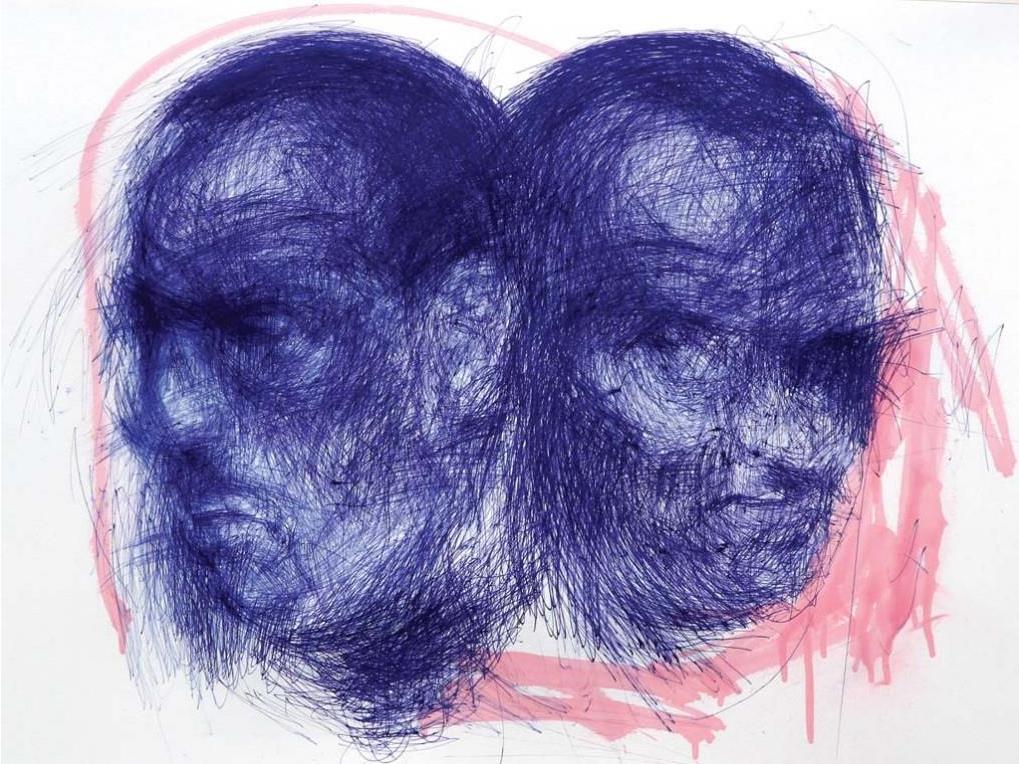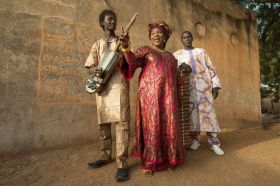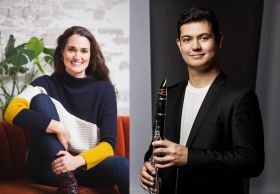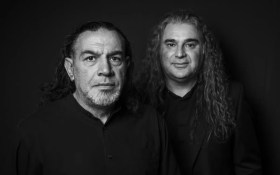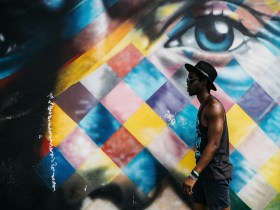Unique talents grow in the west: Andy Quilty, Grow a Pair 2012. Ballpoint pen, enamel and aerosol on Arches paper, 62 x 85 cm. Image via lintonandkay.com.au
The tyranny of myopia continues to skew the chronicle of Australian art history. According to Edmund Capon in his ABC series The Art of Australia, and the interpretation of contemporary art practice in Melbourne and Sydney in Hannah Gadsby’s OZ, art ends at the 129th meridian.
Excuses of distance and expense can no longer justify this carelessness. Capon included one artist from Western Australia, Rover Thomas, but Gadsby failed to acknowledge any creative activity in the state.
While extremely disappointing, this conception of the cultural life of Australia isn’t new: there is an embarrassingly large number of books and curated exhibitions produced over the past century that have egregiously used the prefix “Australian” to describe some aspect of visual art practice on this continent yet exclude any reference to Western Australian artists, galleries or institutions.
Retrospectively, curators and critics have often acknowledged they were remiss in omitting artists, events or works held in public collections in Western Australia from their “national” surveys. Unfortunately, the recorded history is what remains and private apologies do not impact on the next generation of critics, curators or art historians who regularly replicate these oversights.
It’s not surprising, then, that many locally based artists look at their world through a different prism. Living out west encourages them to work globally and think expansively – they are influenced by geography, but not constrained by it. Their horizon is Berlin or Finland, New York or LA.
Many of us left for the lure of swinging London in the ’60s and ’70s; the Triffids were huge in the ’80s in the UK and Scandinavia; and, currently, locally based artists like Oron Catts and Jacobus Capone are working and exhibiting in Berlin and Helsinki, New York and everywhere else.
For them, art isn’t over there, it’s where you are as an artist – and on the western edge of the continent there is a great deal to get the juices flowing.
Along with a raised digit, a give-it-a-go mentality and a dose of fierce optimism, there is also a sense of urgency spawned by dislocation and invisibility that ignites these artists and propels their creative responses to their surroundings, their experiences and their situation.

Living on the west coast is a catalyst for new ideas and new approaches. Aboriginal people have been creating images and responding to the conditions of life here for 40,000 years or more. The Dampier Archipelago Rock Art Precinct comprises the largest concentration of petroglyphs in the world and possibly the largest number of megaliths known in Australia. It also constitutes the greatest continuous cultural site in Australia – and it is one of many.
The galleries of images engraved or painted are a treasure-house of world culture that affirms a vibrant and ongoing engagement with this land. Those same artists have seen visitors arrive on their shores for centuries, welcomed them and shared their knowledge. The Macassans, the Spanish, the Dutch, the French and the British have impacted on their world, and it is reflected in the visual record of their encounters on rock, bark and more recently on paper and canvas.
Later they came to stay. It is frequently the case that the western coastlines of continents attract outsiders later as the great waves of migration and human movement sweep first upon the eastern seaboards and only subsequently find a foothold on western shores.
This lateness in itself offers a kind of freedom, a space to act in response to what is happening elsewhere while not being constrained by it.
In Doug Pray’s documentary Hype (1996), which chronicled the rise of the grunge scene in Seattle (also on a continental western edge), the lack of mainstream infrastructure is described as one of the liberating features that made it possible for young musicians to imagine recording their own music, writing their own magazines and independently distributing their work.
It was the only way to get something happening, and the young musicians and entrepreneurs had the “make do” mentality often associated with the outback, with the new frontier, and the self-reliant, innovative spirit of early explorers and settlers in the “Old West”.
Artists in Western Australia do it too, in full knowledge that if they don’t no one else will. Without the great weight of established corporate monoliths on the doorstep they are free to “have a go”, to see what can be achieved, to break new ground or stir it up. It happens in music, in theatre, literature and most definitely in the visual arts.
As a result, the visual culture of Western Australia documents a local response to international and national issues that, by its very presence, not only contributes to the larger history of Australian visual culture, but also offers a distinctive perspective to that larger narrative.
For Aboriginal artists it is often a process of strengthening culture through reflection and reimagination, for non-Aboriginal artists it can be a mechanism for establishing a sense of belonging, and both groups are now connected internationally through digital networks.
This connectedness provides both camaraderie and also a sense of liberation and independence. Out west has a deserved reputation as a hedonistic environment, but it is also harsh, unique and biodiverse. The extraordinary landscape and ecology demands a response and artists find ways to inflect received knowledge with their experiences of living here.
Both historical and contemporary visual art practice has focused on developments in or from the centre, ignoring the ways in which artists on the periphery, often on the western edge – Los Angeles, Seattle, Perth – respond to these ideas and generate new meanings from their knowledge of their local environment. This is especially true for Aboriginal artists for whom this place is the “centre”, and hence their response to external ideas reflects and refracts that embeddedness.
For non-Aboriginal artists the questions proliferate. Does distance from the centres of world art and national hubs of creative practice generate a vibrant regional identity? Has liberation from the centre led to a different art culture and to alternative forms of practice? Are artists’ practices on the western edge of differing continents comparable and resonant? Is the western edge the frontier or an isolated outpost? Can great art be made here? Is there any better place to make art that is responsive to new ideas and big issues, but with a unique accent?
These were the questions that fuelled discussions when my colleagues and I returned to Perth after the obligatory sojourn in England.
In 1973, I had left Western Australia – for good! Art was elsewhere, not here, and despite some inspirational figures like Howard Taylor and Guy Grey-Smith and irrepressible innovators like Miriam Stannage, the lure of swinging London hooked me and I grabbed it.
Two years later with an unfinished thesis in my bag I was back, defeated by the cold, the damp and perpetual drizzle but re-energised by the vibrancy of an art scene that began in art schools with seductive names like Chelsea, Hornsey and Saint Martins and morphed into exciting and challenging Arts Lab-style spaces across the country and the ICA in London.
This energy swept up to the high-end galleries of Cork, Albemarle and New Bond Streets, and museums like the Tate and the National Gallery, but it was those rough edges at the Birmingham Arts Lab and the ICA that were uniquely intoxicating.
The question for me was could they be replicated in Perth, on the western edge, so far away? Indeed, was there something unique about Western Australia that could add to this heady mix of ideas and practice?
Just after I arrived back in Perth, the intrepid gallerist Rie Heymans announced that she was selling the Old Fire Station Gallery and moving to the position of curator at the University of Western Australia.
My immediate response was to see whether it was possible to raise the money to buy into the gallery myself, and begin to implement strategies to invigorate local practice and celebrate the work of local artists. I tried desperately to pull together enough friends with money to support this lunacy.
Failure was inevitable and swift, but Rie put me in touch with other young artists with similar ambitions and we met to discuss how we might implement change in what seemed like an increasingly stultifying environment for the arts in Western Australia.
Mark Grey-Smith had returned from Chelsea School of Art a few months earlier than me and immediately began to generate support for a new artist-run gallery that would shake-up the conservative art scene in Perth.
The PRAXIS gallery/club house was located in Murray Mews, a run-down laneway that snaked through a derelict part of town, then a lost sector of the city trapped behind the polite facades of infrequently visited city stores. It was most definitely at the wrong end of town, and while His Majesty’s Theatre was just around the corner, it was an area rarely traversed in daylight hours by the passing shoppers patronising Foy & Gibson, Boans, Bairds and Aherns.
In that space PRAXIS organised lectures, including one by visiting American theorist Lucy Lippard, and exhibitions that drew together an entirely different crowd of people from those usually found at Sunday afternoon openings at the Art Gallery of Western Australia, the Old Fire Station or Skinner Galleries.
PRAXIS was a direct outcome of the optimism generated by Whitlam’s election slogan: It’s Time. It seemed possible to propose radical new alternatives and to expect they would succeed. In Perth there was an additional urgency fuelled by a shared sense of dislocation, isolation and stuff-you larrikinism.
Not surprisingly then, a major feature of the cultural landscape in late 1975 was the sacking of the Whitlam government, which acted like a pin in the balloon of our self-confidence. After all, this was the government that bought Jackson Pollock’s Blue Poles and had engineered our withdrawal from Vietnam, which had made us proud to be Australian.
Now we were returned to Liberal rule, to the boring predictability of Malcolm Fraser, who refused permission for the Australian National Gallery to buy George Braque’s Grand Nu. It was incredibly deflating, and we all felt it deeply.
By the end of the year PRAXIS was languishing too, and although it would be foolish to place the entire blame on the changing political climate, it was certainly true that our sense of hope had been punctured.
Despite concerns about the likelihood of moral corruption if the group accepted money from an external body, expressed with unregulated vehemence by Mark Grey-Smith, it was finally agreed to seek out additional funding from the Perth City Council. With a base funding and a program of exhibitions planned around a single conceptual idea, to which individuals would contribute, the first year of the newly restructured PRAXIS looked very bright.
The inaugural event was organised by Geoff Jones in May 1976. Life Class was intended to provoke a reaction from the media, and with the help of committee member Kim Humphries’ connections through the ABC it did just that.
Of course, a pair of naked models sitting like statues is the stuff of every life-drawing class, but the shock value of a young naked man and woman presenting themselves unprotected to the gaze of others was incendiary to the general community. Despite the row of young art students shown drawing the two handsome German models, the coverage on the ABC’s current affairs program This Day Tonight was all we had hoped for.
With one event, PRAXIS was launched into the local community as an organisation at the dangerous edge of outrage and subversion. It was laughable, but it was effective, and the results in terms of funding and support were palpable.
The exhibitions that followed were more intelligent and considered, though much less inflammatory, which certainly disappointed many of those who clambered up the narrow stairs with high expectations of titillation and scandal. The Light Show was followed by The Head Show, The First Picture Show, The Environment Shows I, II & III and The Found Object Show, which drew an enthusiastic review, “Finders still keepers” by Patrick Hutchings in The Australian on 25 June 1976:
Happenings don’t in Perth, and conceptual art is rarely conceived outside the loft of PRAXIS, the local young artist’s co-operative. Most PRAXIS exhibitions are group affairs, and a degree of anonymity, even, is sought but not always achieved. Ted Snell poises his sets of objects between the theoretical extremes; Theo Koning presents with an authority that makes the fall of objects look as serendipitous as their finding; Debbie Cain presents objects in a way that carefully stresses that they are single things and no more. Subject and object meet, pointedly, in “salvaging”. For anyone’s bit of picked-up and treasured junk, melted bottle, rusted mincer, attaché case of textile scraps, we can ask, as the whole PRAXIS show does: What’s it to you?
There was certainly a hint of what’s it to you? about PRAXIS; it presented an alternative to what was seen as the safe and predictable commercial gallery scene and the stuffy, traditionalist and ultra-conservative State Gallery.
The Ego Show was an affront both artistically and conceptually. It was a purposeful statement about identity and reflected the self-confidence of emerging artists no longer prepared to accept the status quo. The quintessential expression of that self-confidence was the final work, completed just minutes before the show opened.
A young artist from Claremont School of Art named Mary Moore walked into the gallery and, spying an empty wall, asked if she could be in the exhibition. Following a short exchange, she rolled up her sleeves, dipped a huge brush in black paint and simply wrote her name in huge letters across its entire length.
It was fantastic, extraordinary and succinct, brilliantly clever and absolutely intuitive. It was a PRAXIS gesture par excellence, a raised index finger, a confident gesture of belonging and a reaffirmation of the power of art to provoke, inform and challenge. She was remarkable then and even more so now. We married in 1982.
Then, just when everything seemed to be coming together, a bombshell! The lease on the gallery premises was not renewed and PRAXIS was left without a home. The city was finally encroaching on the “bad end of town” and the run-down back lanes and side streets of the area were well on their way to their present status as highly desirable real estate.
Always resilient, the next phase of PRAXIS evolved with Brian Blanchflower and myself holding the company seal. PRAXIS had become an incorporated body, which enabled the group to seek and receive funds from government agencies. This new status enabled other artists to run programs under the PRAXIS banner and for members of the group to present their projects.
It then moved to Fremantle and gradually transformed into the Perth Institute of Contemporary Art (PICA), taking up residence in the Old Perth Boys School in James Street under the direction of Noel Sheridan in 1989.
Although hardly a blip on the national consciousness – and only acknowledged cursorily in the Australian and Art & Australia – PRAXIS achieved its goal of energising a younger generation of artists by challenging them to make art that was relevant to this place while intently aware of international concerns.
Since PRAXIS there have been many other artist-run initiatives (ARIs), all of which have reflected that same larrikin spirit and pugnacious insistence on changing the game plan. If not acknowledged locally or nationally, then they are determined to do it anyway and look to new audiences – elsewhere!
Some of these ARIs are still around; others had shorter bursts of activity. Some were large, others a converted garage, but all wanted to have an impact by encouraging local practice, nurturing local artists and confronting a community that stalwartly ignored them and their activities.
They include Gotham Studios, 6A.N.I.C.A. Gallery and Studios, Jacksue Gallery, Verge Gallery, Spiral Studios, The Terminal, Kurb, Venn, Anthony Riding, OK, the Museum of Natural Mystery, Galleria and, recently, Moana Project Space, whose mission sums up the spirit and vision of PRAXIS and all those they succeeded, to create what Kate Mullen and Dale Buckley described in an email to me on 30 April 2014 as an “independent art space dedicated to presenting experimental and diverse practices to a consistent and critical degree”.
In the face of the closure of many of Perth’s established commercial art galleries, Kate Mullen and Dale Buckley grasped the opportunity presented by the Moana Chambers redevelopment project in the Hay Street Mall in Perth city to fill a gap in the local arts infrastructure.
Several innovative ARIs have been established following those closures, and Moana Project Space needed to assert a point of difference, so they created, in their own words, “a platform for collaborative curatorial and experimental projects, somewhere between an artist-run, not-for-profit project space and a small institution with a dedicated focus on curation and inter-disciplinary, inter-state collaboration”.
As a result, Moana is as much a laboratory for curatorial experimentation as it is a hothouse for nurturing new work and bringing together artists, curators and collectors.
There are evident similarities between PRAXIS and Moana. As well as the basic premise that spawned them, they both chose old buildings in the city centre reached via a flight of stairs and patrolled by the artists whose work is on show. There is also a similar sense of optimism and urgency fuelled by dislocation and invisibility.
Like their predecessors, the current generation of emerging Western Australian artists showing at Moana, Paper Mountain and other local ARIs is energised by living on the west coast. Abdul Abdullah, Anna Richardson, Casey Ayres, Nathan Beard, Tom Dudley, David Brophy, Anna Dunnill, Teelah George and so many more are not oblivious to the art scenes of Sydney and Melbourne, but they are keenly aware of what is happening in Berlin, London, New York, Shanghai and Hong Kong – and more attracted to visit and to engage there.
Hopefully, they will achieve the success they deserve both locally and internationally, and in the future when Australian-based critics and curators are interrogating the contemporary visual arts nationally, their achievements will be acknowledged as part of a comprehensive, informed and unblinkered version of Australian art history.
This essay was originally published in Griffith REVIEW 47: Looking West and republished on The Conversation. Read the original article.
